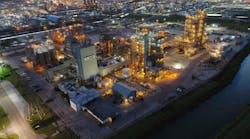Two months ago (Flow Control, August 2013, page 14), I described the decision process used in the mid-1980s to apply a Coriolis mass flowmeter in ammonia service operating at a relatively low density and the apprehensions about using this device for this application. Last month (Flow Control, September 2013, page 14), I described the Coriolis mass flowmeter installation that created such a large obstruction to flow that the flowmeter would not pass (even close to) the operating flow.
The first order of business the next day was to call the engineer at the factory, describe the situation, and ask him to investigate. A few hours later, the engineer called and told me that the Coriolis mass flowmeter was undersized—the correct size is 1.5".
It is understood that sizing errors can occur, especially for a non-standard application such as this. However, using a 1.5" Coriolis mass flowmeter—a full three pipe sizes less that its piping—was rather concerning because installing the wrong size flowmeter again would be an embarrassment for the manufacturer and me—even if I did act on the best available information. The engineer assured me that the 1.5" Coriolis mass flowmeter would work and that its pressure drop at design conditions would be approximately 400 mbar (6 PSID).
The plant fabricated two more spool-pieces, removed the existing vortex shedding flowmeter and installed the 1.5" Coriolis mass flowmeter. I was present when it was operating and heard it produce a high-pitched sound. The flowmeter was barely able to pass the design flow while operating at almost double the nominal operating pressure. This was deemed unacceptable and the 1.5" Coriolis mass flowmeter was removed and the existing vortex shedding flowmeter was re-installed (again).
Strike two!
More next month…
NEXT ARTICLE: Strike 3!—Specifying a Coriolis flowmeter for gas service
David W. Spitzer is a regular contributor to Flow Control magazine and a principal in Spitzer and Boyes, LLC offering engineering, seminars, strategic marketing consulting, distribution consulting and expert witness services for manufacturing and automation companies. He has more than 35 years of experience and has written over 10 books and 250 articles about flow measurement, instrumentation and process control.
Mr. Spitzer can be reached at 845 623-1830 or ?www.spitzerandboyes.com. Click on the “Products” tab to find his “Consumer Guides” to various flow and level measurement technologies.



